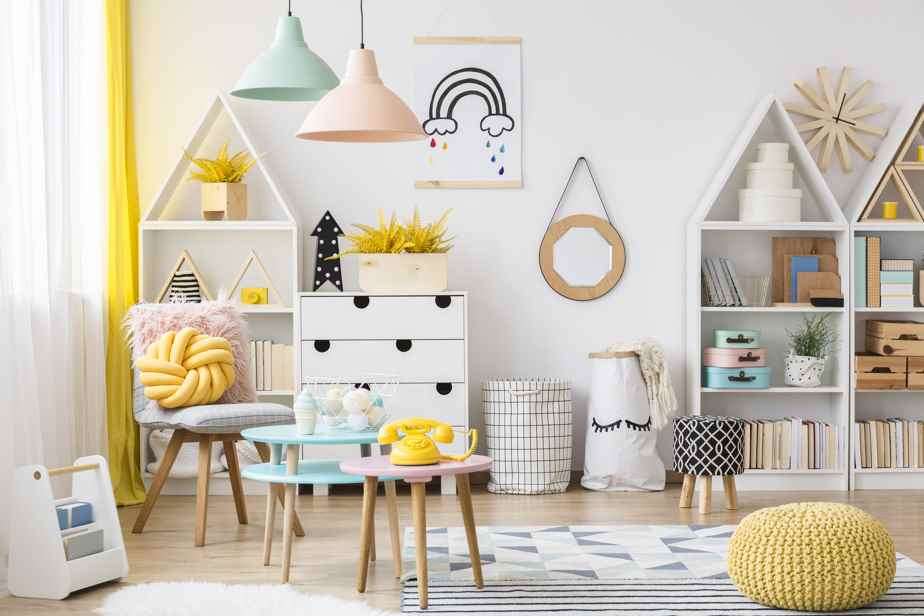That’s it, the holidays are behind us. But the gifts that our children received are still there. How to coexist with these new toys, which seem always bigger? Experts help us tidy up our homes…and our minds.
“There’s a lot of research showing that having too many toys isn’t good for children,” says Tinka Markham Piper, a professional at the organization who helps people manage their interiors. “And when very big toys come into the house, they take up a lot of space, which can cause all kinds of tensions: you don’t know where to put them, or they can break”, continues the one who is at home. head of Solve my Space.
Surprising that these seemingly innocuous objects can have such an impact? Not that much, according to the “chaos counselor,” who also describes herself as a therapist, because so much of the work is emotional. Luckily, there are ways to structure your home so that humans and toys live in harmony.

PHOTO PROVIDED BY DE HUT
Arranging the toys on shelves or even in small wooden houses allows them to be seen at a glance. On the other hand, we can put cushions or blankets in baskets.
Give them a home in the house
We know that when each object in our home has a designated place, we already think more clearly. The same logic applies for toys. The idea is to give everyone “their house in the house”, illustrates Tinka Markham Piper.
For toys, we want them to be easy to access, easy to clean and for children to know where to put them.
Tinka Markham Piper, Organizing Professional
-

PHOTO MARCO CAMPANOZZI, PRESS ARCHIVES
Tinka Markham Piper, founder of Solve my Space
-

PHOTO PROVIDED BY SOLVE MY SPACE
Examples of Tinka’s work at clients. Here, books arranged on shelves, and others in baskets on wheels below.
-

PHOTO SARA OTTOBONI, PROVIDED BY SOLVE MY SPACE
IKEA’s Kallax shelves allow you to arrange books, toys, games, in cubes, or in baskets that you slide in, like with this customer from Solve my Space.
1/3
In addition, it is better to avoid tossing everything in a giant basket, and instead opt for shelves where you can have an overview of each object, suggests Charlotte Verbiest, owner of the online store De Hut, which sells accessories for children. “When children see all the games they have received, then they can really play with them. »
Tote bags, however, can do wonders for reducing the amount of stuff in the bedroom, for example to group cushions or blankets, says Charlotte Verbiest. You can also put stuffed animals there, where they may live better than on shelves, underlines Tinka Markham Piper.

PHOTO FROM THE ATELIER BOSC WEBSITE
You can make a selection of children’s books and then change them after a while. Here, a library from the Atelier Bosc.
Spin
Too many to see it all at a glance? Our two experts suggest rotating the toys, that is, “hiding” some of them for a while, to better bring them out later. A strategy that has proven itself with children, who are generally very happy to find certain favorites that had fallen into oblivion.

PHOTO PROVIDED BY DE HUT
Another example of a library where the books are in full view (against the back wall)
The same logic applies to books, adds Charlotte Verbiest. “We do rotations: Christmas books, winter books, autumn books… It plays a lot on the visual aspect,” she says.
Then, we can think about its storage according to the size of the toys. For example, smaller pieces like Lego bricks could find their place in transparent bins with a lid. We can thus see the content and even identify it. “For each toy, you have to think about what kind of box or bin will suit it,” says Tinka Markham Piper.
So many of her customers opt for IKEA’s Kallax shelf, made of cubes stacked on top of each other, because it’s easy to customize. Bins and boxes can also be integrated.

PHOTO GETTY IMAGES
Tinka Markham Piper recommends grouping large toys in one place around the house. Each family can choose the place that suits them best.
And the big ones?
Ah! The issue of large toys. “Often it seems that the smaller the children, the bigger the toys! notes Tinka Markham Piper, proposing a few strategies to integrate them into the decor.
First, it is wise to group them in one place in the house, rather than scattering them in each room. There, you can either line them up in a corner or under a bench, for example. Large toys are slid underneath, where they will be easy for children to access, and baskets containing the smallest toys are placed on top.
“I think the key with big toys is grouping them together. We can see how many we have, and if there are too many, maybe we can give some, ”suggests Tinka Markham Piper. Yes, you read that right: she suggests donating them to a daycare or hospital, for example, where they’ll be most useful.
Storage recommended by our experts
-

PHOTO FROM DE HUT WEBSITE
Nobodinoz bag, perfect for stuffed animals, blankets, cushions, $78 on the De Hut website. Suggested by Charlotte Verbiest.
-

PHOTO FROM DE HUT WEBSITE
Teddy basket, practical for sorting baby products, $32 on the De Hut website. Suggested by Charlotte Verbiest.
-

PHOTO FROM IKEA SITE
Tinka recommends several IKEA boxes and bins, including Dröna (our photo), Tjena, Risatorp, Kuggis and Samla.
1/3
